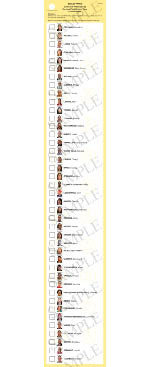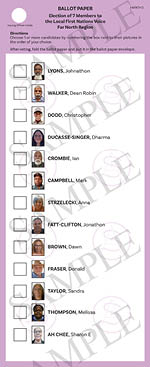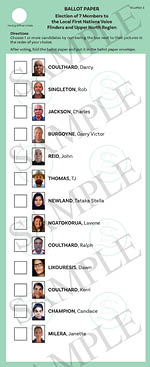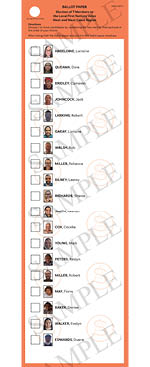Declared Institutions
To make sure every eligible voter has the chance to participate in state elections and by-elections, we provide dedicated voting services for people living in hospitals, nursing homes, and other institutions, including correctional facilities. These locations are known as Declared Institutions.
In the lead-up to an election, trained and vetted Electoral Visitors are sent to these institutions to assist residents with casting their vote in person. This service usually runs from 9 am to 5 pm, Monday to Friday, during the week before polling day. In some cases, it may continue until 6 pm on polling day itself.
Details about when and where Electoral Visitors will be available are published on our website closer to each election.
Residents who prefer to vote by mail can also apply for a postal vote.
Please note: this service is designed specifically for patients and residents of these institutions. It is not available to staff or visitors.
Failure to vote
The Electoral Commission takes its role in the management of the democratic process seriously, and that elections are met fairly, honestly and within the law. This also means following up those people who didn't vote. We refer to this as the "non-voters" process.
It is important to know about upcoming elections in your area, as not knowing about an election is not a valid reason for failing to vote.
The best way to be informed about upcoming elections is to ensure to keep your details up to date. Providing a mobile number or email address will enable reminders about upcoming elections to be sent to you.
Below is an overview of our non-voters process
Non-voter process
If it appears you did not vote, you will receive the following 3 notices in accordance with section 85 of the Electoral Act 1985 and the Expiation of Offences Act 1996. The final stage is to refer the matter to the Fines Enforcement and Recovery Unit.
Note: You can provide a valid and sufficient reason at any time and you will not proceed to the next stage of the process.
Apparent failure to vote notice (First notice)
This notice is sent within 90 days following the election. It gives you the opportunity to explain why you didn't vote, OR if in fact, you did vote. This notice (and all subsequent notices) will be sent to address on the electoral roll, at the Close of Rolls for the election
It is an offence not to respond to this notice.
If you receive an apparent failure to vote notice, follow the instructions on the letter i.e. complete all relevant sections, have it witnessed (it can be witnessed by anyone e.g. a family member, a friend, a colleague, a neighbour.) and return to us in the supplied reply-paid envelope or alternatively scan to PDF and email to
If your reason is accepted there is no further action.
Your response must be received by ECSA on or before the date indicated on the notice.
Important Note: your reason/s for not voting cannot be accepted / rejected over the phone. You must return the notice, via the methods mentioned above
Expiation notice $112 (Second notice)
You will receive an expiation notice if you do not respond to the apparent failure to vote notice, OR if you don't provide a valid and sufficient reason for not voting.
The expiation notice is issued under the Expiation of Offences Act.
The expiation amount is a $10 expiation fee for the offence and a $102 victims of crime levy.
Your options in dealing with the expiation notice are set out in the Expiation of Offences Act and are included on the reverse side of the expiation notice.
They are:
- Pay the fine
- Enter into a payment arrangement
- Elect to be prosecuted (which means having the matter dealt with by a court)
- Apply for a review of the expiation notice
You can provide a valid and sufficient reason at any time and you will not proceed to the next stage of the process.
Expiation reminder notice $185 (Third notice)
A reminder notice is issued if you fail to respond to the previous 2 notices. You will be required to pay the original fine plus a fee of $73.
Your options in dealing with the reminder notice are set out in the Expiation of Offences Act and are included on the reverse side of the notice.
They are:
- Pay the fine
- Enter into a payment arrangement
- Elect to be prosecuted (which means having the matter dealt with by a court)
- Apply for a review of the expiation notice
You can provide a valid and sufficient reason at any time and you will not proceed to the next stage of the process.
Note: All fines and fees are subject to change. These fines incorporate a victims of crime levy and other fees as per the Expiation of Offences Act.
Notice of order of enforcement
After 3 notices have been issued, the Electoral Commission SA refers the matter to the Fines Enforcement and Recovery Unit, if you:
- fail to pay the fine, or
- do not provide a valid reason for not voting.
The Fines Enforcement and Recovery Unit issues a notice of order of enforcement, which carries significant financial penalties in addition to the current penalties.
How to pay your fine
There are a few ways you can pay your fine prior to enforcement, these include:
- BPay
- credit card
- over the phone
- in person
- apply for a payment arrangement with the Fines Enforcement and Recovery Unit
You will need your expiation notice as it contains an identification number specific to you.
If you have misplaced your expiation notice, or would like to discuss your notice, please contact the Electoral Commission SA.
- Phone 1300 655 232 within SA only
- Phone 08 7424 7400 from interstate
- Phone +61 8 7424 7400 from overseas
- Email
This email address is being protected from spambots. You need JavaScript enabled to view it.
Address: Level 6, 60 Light Square, Adelaide SA 5000 (Find us on the map using this link)
Postal: Electoral Commission SA, GPO Box 2072, Adelaide SA 5001 (No stamp required)
Fines Enforcement and Recovery Unit
Once your fine is enforced (overdue) you must contact the Fines Enforcement and Recovery Unit as the Electoral Commission SA can no longer accept payments.
How to pay your overdue fine
The Fines Enforcement and Recovery Unit has flexible options to pay your fine.
Overdue fines can be paid:
- online
- via telephone
- in person at any Australia Post office or Service SA Customer Service Centre.
You can also apply for a payment arrangement to spread your payment over a longer period.
Where a matter is not dealt with, the Fines Enforcement and Recovery Unit will apply escalating enforcement measures to recover the amount owed. These enforcements may include:
- suspension of your driver's license
- deductions directly from your salary or bank account
- clamping and impounding vehicles
- seizing and selling assets
Contact the Fines Enforcement and Recovery Unit on 1800 659 538 or visit Fines SA.
How-to-vote cards
How-to-vote cards (HTV) are prepared by a party, group or independent candidate.
They indicate how they want you to record your preferences when voting.
It is up to you whether you follow a HTV card or mark your ballot papers according to your own choices.
There are 2 types of HTV cards:
- A HTV card lodged with the Electoral Commission of South Australia for display in polling booths and early voting centres.
- A HTV card lodged with the Electoral Commission of South Australia by a person who intends to distribute the card during the election period.
Political party and candidate workers
Political party and candidate workers may be outside polling places with HTV cards showing you how they would like you to vote for their candidate.
You do not have to take these if you don't want to.
A person must not distribute a HTV card during the election period unless it is substantially the same as a card lodged for display in polling booths or lodged with Electoral Commission of South Australia.
How to complete your ballot papers
The way to complete your ballot papers is different at each type of election in South Australia. On this page you can find instructions on how to complete your ballot paper correctly at each election.
State elections and by-elections
When voting in a state election you will be given 2 ballot papers: a small green paper for the House of Assembly, and a large white paper for the Legislative Council. At a by-election, you will just be given a green House of Assembly ballot paper.
House of Assembly
On the green House of Assembly ballot paper, you need to number every square in the order of your choice.
- Write the number 1 in the square next to the candidate who is your first choice
- Write the number 2 next to your second choice
- Continue by placing the numbers 3, 4, 5 and so on until you have a number in every square.
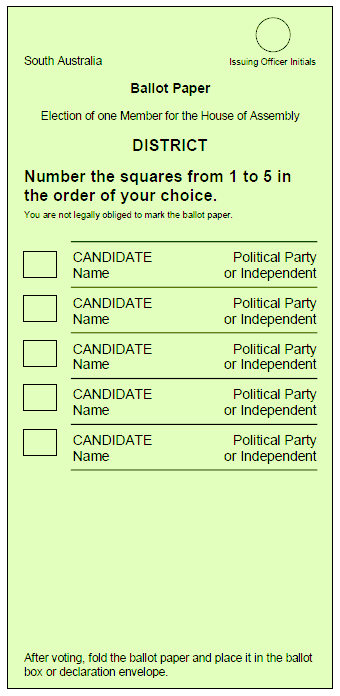
If you need assistance or make a mistake please see an electoral officer.
You can practice making a formal vote by using our interactive ballot paper below:
House of Assembly practice ballot paper >>
Legislative Council
On the white Legislative Council ballot paper, there are 2 ways you can vote. Either above the red line or below the line - but not both.
Vote above the red line:
If you choose to vote above the red line:
- Write the number 1 in the square next to the party or group of candidates which is your first choice.
- You can then write the number 2 next to your second choice, and so on for as many parties or groups of candidates as you like. You do not need to number every square.
- Leave the rest of the ballot paper blank. Do not mark below the red line.
By voting above the red line, your vote will go to the candidates within the group (or groups) you have chosen.
Vote below the red line:
If you choose to vote below the red line:
- Write the number 1 in the square next to the candidate who is your first choice.
- Continue by placing the numbers 2, 3, 4, 5, 6 in the squares next to the other candidates of your choice until you have chosen a minimum of 12 candidates.
- You may choose to continue numbering more than 12 candidates.
By voting below the red line, you are deciding the order of candidates according to your preferences.
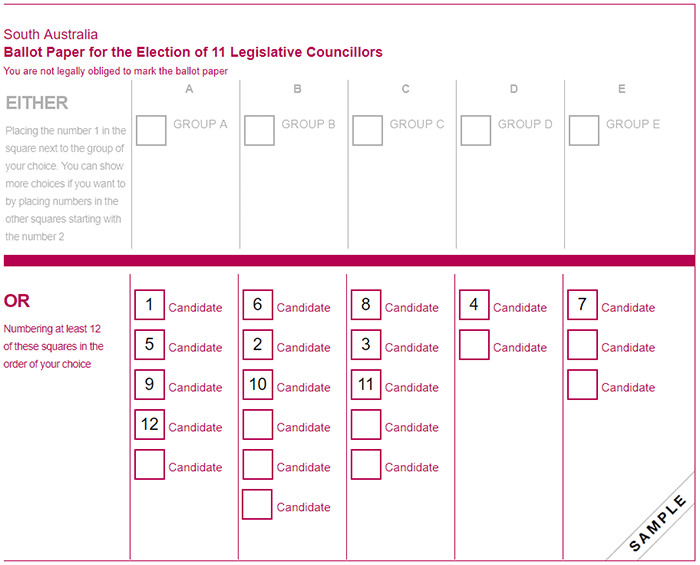
If you make a mistake, don't worry. Put a line through the mistake and write the correct information beside it, or you can ask an electoral officer for a replacement ballot paper.
You can practice making a formal vote by using our interactive ballot paper below:
Legislative Council practice ballot paper >>
First Nations Voice elections
When voting at a First Nations Voice election you will be given a ballot paper showing all the candidates for your region.
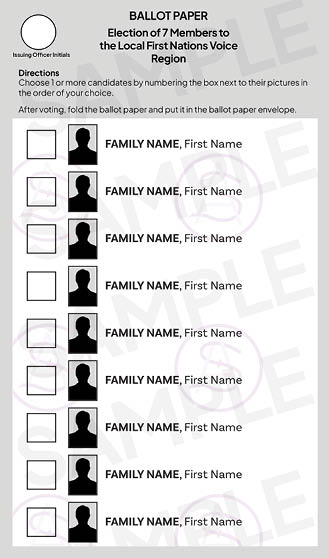
To vote, you must write a number 1 in the box next to the name and photo of the candidate who is your first choice.
If you want to, you can vote for more candidates. Write the number 2 in the box next to the candidate who is your second choice, the number 3 in the box next to the candidate who is your third choice and so on.
Continue on until you have voted for all the candidates you want to.
You don’t have to number every box.
Remember, it’s your choice how many candidates you vote for.
You don’t have to vote for more than 1 candidate, but your Local First Nations Voice will have 7 or 11 elected representatives, so it is a good idea to vote for multiple candidates to represent you.
If you only vote 1, your vote can only help 1 candidate to get elected. The more candidates you vote for, the more you can help your preferred candidates get elected.
To view and download a copy of the 2024 Local First Nations Voice election ballot papers, click on the pictures below.
| Sample ballot papers | ||
|
Central |
Far North |
Flinders & Upper North |
|
Riverland & South East |
West & West Coast |
Yorke & Mid-North |
More information
Download a copy of our easy read guide on voting at state elections (PDF, 1.5MB)
Download a copy of our easy read guide on voting in a by-election (PDF 2.64MB)

